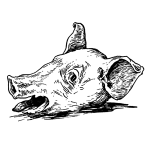1. NATURAL HUNGERThis is the meal equally set—this the meat for natural hunger;
It is for the wicked just the same as the righteous—I make appointments with all…
—Walt Whitman, “Song of Myself”
This is the meal equally set—this the meat for natural hunger;
It is for the wicked just the same as the righteous—I make appointments with all…
—Walt Whitman, “Song of Myself”
In January 2001, the news from Europe read like a low-budget horror movie, and it worsened with the same implausible rapidity and reach. Human brains infected with Creutzfeldt-Jakob disease, the human variant of mad cow disease, were literally turning into sponge. And mad cow had spread because, in an abysmal twist, we’d been feeding cows to cows—and maybe also because, when that was outlawed, we went on feeding cows to chickens and chicken poop to cows. The media stunned us with lists of surreptitious beef-industry by-products: cow blood in fire extinguisher foam and plywood adhesive; tallow in waterproofing agents, acne medication, lubricants for jet engines, and wiring insulation for electronic appliances. Beef suddenly terrorized us, its menacing ubiquity enforced by the slogan “It’s what’s for dinner.”
The following month, the fields were aflame! To quash a second epidemic, hoof-and-mouth, European ranchers rounded up, shot, incinerated, and/or buried the carcasses of more than ten million animals. In Great Britain, the fat rendered from this mass slaughter, added to that of the hundreds of thousand of cattle culled to beat the first mad cow outbreak five years earlier, left the country with a storehouse of nearly half a million pounds of tallow. Entire herds lay stacked in mass graves, discarded like pallets of defective merchandise. To put it mildly, all things concerning the meat industry suddenly seemed a little bit suspicious and a little bit out of control. We watched the apocalyptic footage of smoldering cattle pyres on the nightly news and wondered how the flab of a living, 1,200-pound quadruped wound up coating the wires inside the television.
Then on January 17, 2001, in a stroke of purely accidental marketing synergy, Eric Schlosser published Fast Food Nation: The Dark Side of the All-American Meal. Schlosser provided facts and figures with which to buttress our newfound quease. Though mad cow and hoof-and-mouth barely received mention in the book, Schlosser exposed a beef industry that was both benignly negligent and purposefully exploitative of its animals, labor, and customers. His was a forceful work of muckraking at a time when troubling traces of that muck had already been wafting up on their own.
The book wrapped razor-sharp reporting in a literary style, quickly becoming the marquee work of an already burgeoning literary genre: Popular Meat Writing. Its runaway success with the general eating public helped cement a market for lively, incisive writing about livestock and meat production, on bookshelves and in newspapers and magazines nationwide—works like...
You have reached your article limit
Sign up for a digital subscription and continue reading all new issues, plus our entire archives, for just $1.50/month.
Already a subscriber? Sign in





